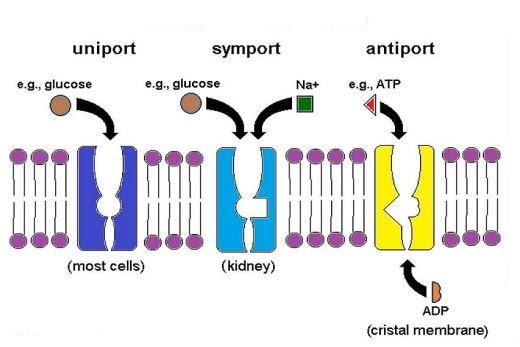
What is Facilitated diffusion? How is symport transport different from antiport transport?
Answer
482.4k+ views
Hint: Transport in membranes deals with the movement of materials across the membranes of cells. Transport is a necessity for the cells for the uptake of nutrients. This activity along with the movement of ions and other molecules is offered by proteins and protein complexes, which are highly specific for the compounds they move. This selective movement and ions’ lower permeability across the lipid bilayer aid in maintaining the osmotic balance of the cell.
Complete answer
Other names for the facilitated diffusion are facilitated transport and passive-mediated transport. It is opposed to active transport and is a process of spontaneous passive transport of ions or molecules across a biological membrane through specific transmembrane integral proteins. It occurs when the driving factor for the movement is diffusion.
The driving force for facilitated diffusion is concentration. The materials move from a side of higher concentration to a side of lower concentration and by the end of the process, the concentration of materials on both sides are equal. Red blood cells acquiring glucose is an example of facilitated diffusion.
Fig.: Symport, Antiport and Uniport modes of Transport

Note:
Both symporter and antiporter act as cotransporters and are a type of secondary active transport. Uniport is an integral membrane protein, where transport of only one molecule is involved. Carrier proteins are involved in primary active transport, whereas transmembrane proteins are involved in secondary active transport. The antiporter transport substrates in two directions, whereas both uniporter and symporter transport molecules in a single direction.
Complete answer
Other names for the facilitated diffusion are facilitated transport and passive-mediated transport. It is opposed to active transport and is a process of spontaneous passive transport of ions or molecules across a biological membrane through specific transmembrane integral proteins. It occurs when the driving factor for the movement is diffusion.
The driving force for facilitated diffusion is concentration. The materials move from a side of higher concentration to a side of lower concentration and by the end of the process, the concentration of materials on both sides are equal. Red blood cells acquiring glucose is an example of facilitated diffusion.
Fig.: Symport, Antiport and Uniport modes of Transport

| Symport Transport | Antiport Transport |
| A symporter is an integral membrane protein. It is involved in the transport of various kinds of molecules across the cell membrane. As two molecules travel in the same direction in relation to each other, the transporter is called a symporter | An antiporter is also an integral membrane protein, but two molecules travel in opposite directions in relation to each other. |
| Sodium sugar pump and hydrogen sugar pump are involved in the symport transport system. | Sodium potassium pump and sodium-calcium exchanger are involved in the anti-port transport system. |
Note:
Both symporter and antiporter act as cotransporters and are a type of secondary active transport. Uniport is an integral membrane protein, where transport of only one molecule is involved. Carrier proteins are involved in primary active transport, whereas transmembrane proteins are involved in secondary active transport. The antiporter transport substrates in two directions, whereas both uniporter and symporter transport molecules in a single direction.
Recently Updated Pages
The number of solutions in x in 02pi for which sqrt class 12 maths CBSE

Write any two methods of preparation of phenol Give class 12 chemistry CBSE

Differentiate between action potential and resting class 12 biology CBSE

Two plane mirrors arranged at right angles to each class 12 physics CBSE

Which of the following molecules is are chiral A I class 12 chemistry CBSE

Name different types of neurons and give one function class 12 biology CBSE

Trending doubts
One Metric ton is equal to kg A 10000 B 1000 C 100 class 11 physics CBSE

Explain zero factorial class 11 maths CBSE

What is 1s 2s 2p 3s 3p class 11 chemistry CBSE

Discuss the various forms of bacteria class 11 biology CBSE

State the laws of reflection of light

Difference Between Prokaryotic Cells and Eukaryotic Cells




